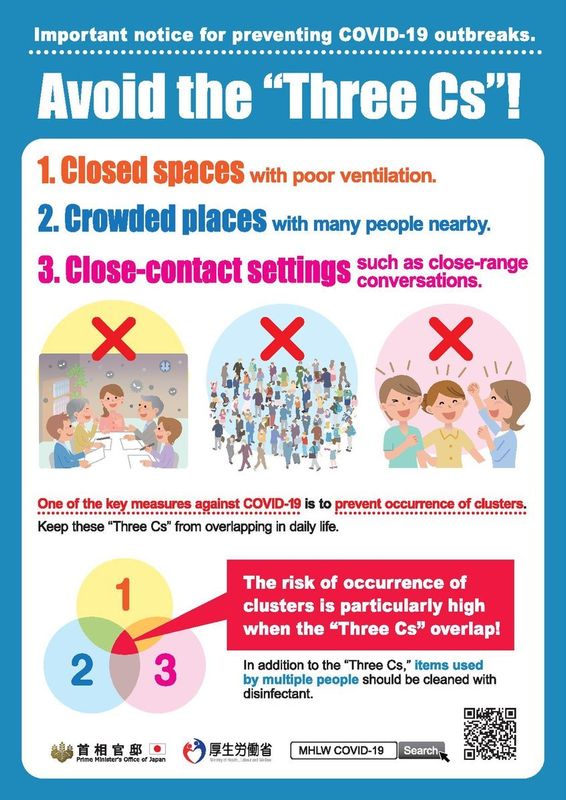Jun 17, 2020
Plague Diary 16 The New Normal

Ministry of Health, Labor and Welfare
In the media, in conversation in whichever language, the new normal inevitably comes up. An expression I acquired is “coronaverse”, and some friends refer to the era we live in now as A.C. for After Corona, while the life we led six months ago is B.C., Before Corona. The Japanese media calls our new normal 新たな日常, atara nichijou, and work communication describes our new lifestyle as 新しい生活様式 atarashii seikatsu youshiki.
Home front and Abroad
During the state of emergency and as we ease out, the social life squeeze has been tough. Social media is my connection with both friends abroad and neighbors here. Friends are observant of social distancing, especially older people. Even with the easing, I’m still depending on messaging and video/voice calls. I only keep company with an invalid neighbor. Visits keep him buoyed while he recovers mobility, and I get exercise as I run errands for him.
It’s been awful for some friends whose foreign spouses were working abroad on the wrong side of travel restrictions. Japan’s Ministry of Justice is now allowing some categories of foreign residents to return.
Work
At the high school in which I teach, the nurse announces via email and morning meetings measures to avoid infection. The nurse’s room has become a crucial to our safety. At the school bus stop, a team performs temperature checks and confirms students have masks. Bus seating means observing social distancing, reducing rider capacity. The result is staggered attendance. On campus, students must use alcohol hand spray, keep masks on, and refrain from physical contact. The last point is lost on junior high students who horse around and hug on breaks between lessons.
We were issued paper masks and face shields. I understand the impulse when I look around our staff rooms, populated by many veteran teachers over 50 years old, the demographic most at risk from severe effects of coronavirus. We’re scared for the health of our older staff members.
Online emergency instruction is chaotic. The school assigned me first year students, and we’ve only met virtually. My colleagues and I deliver online asynchronous lessons – not live – and have produced presentations, videos, and digital materials, but can only provide a fraction of our usual syllabus. Both teachers and students are learning not only school subjects but also the learning management system, in our case, Google Suite. Half my time is spent technical troubleshooting and instructing English, and the rest as digital content creator. I feel like a student teacher again, learning a whole new skill set which has made teaching more dynamic and communicative than ever before. But the steep learning curve means I work much longer hours. As I get more proficient, it will become more manageable.
Traditional Arts
For two decades I’ve been training in Japanese martial arts. Our martial school closed its doors when Prime Minister Abe requested school closures. We can’t in good conscience open after lifting the state of emergency because many of the martial arts require physical contact, and our membership demographic skews over 45 years old. In my region, so far low contact arts such as kyudo, traditional archery, return in mid June. Japanese martial arts, especially traditional classical schools were already suffering the existential threats of the aging society and a lack of interested young people. The pandemic’s disruption is a danger to the performance and preservation of styles that are communicated from heart to heart, from teacher to student. It’s a source of heartbreak for our senior teachers. We younger ones worry we will get rusty.
Tourism
For some years, I’ve been writing in English, mostly tourism information and living information. It’s been fun, encouraging me to visit places I wouldn’t otherwise go, and research topics new to me. It’s broadened my knowledge of Japanese traditional and pop culture. I’ve become more conscious of the tourism industry, what attracts visitors from abroad, and what’s of interest to resident foreigners. Now, I limit my stories to essays I can cover from home, or local stories I can cover on bicycle trips.
Travel restrictions continue, and inbound tourism is moribund. The chamber of commerce with which I volunteer has had tourism campaigns put on hold. It’s hurting our local businesses which have served inbound visitors for decades. The economic fallout continues, with no end in sight.
Surprising Effects
Keeping up with the barrage of medical jargon and terms about the state of emergency means my Japanese vocabulary proliferates as I read Japanese media and my city’s website. To be honest, I’ve resorted to translation engines such as Jim Breen’s Japanese page, and DeepL. The good part is skimming original articles results in gains in reading and listening.
As a bicycle and train commuter, I’ve been grateful for dense mass transit and safe roads. However, since early March, my freedom of movement has been curtailed, and I only range about 15 km from home by bicycle. Although I have been working from home, I have been compelled to cycle to work a few times a month. I’ve also biked a few cities away to support local business owners and see friends while observing the “three Cs”.
The net effect is commuting costs are near zero, and I no longer do Tokyo trips. The luxuries that I treated myself to – world class salons, international cuisine, fashion – aren’t accessible, so my spending has dropped. Now, I appreciate even more the lifestyle I led B.C., living in proximity to one of the great capital cities of the world.



0 Comments